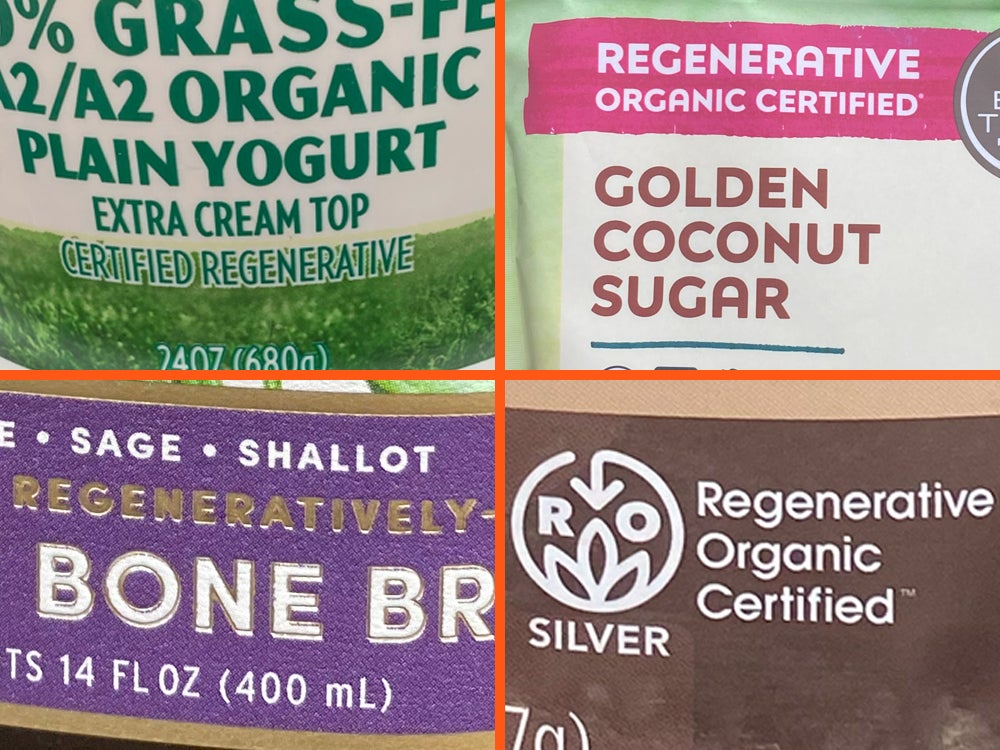This story has been updated. It originally published on Jan. 25, 2024.
Stroll through a grocery store and you’ll likely spy the word “regenerative” on everything from cocoa powder to hot dogs. You can even make a stiff old-fashioned from regenerative whiskey. But this seemingly climate-conscious term is slippery. There’s no federally regulated definition of the word “regenerative” the way there is with organic, and the term’s buzzwordification is only making things slipperier. So what does regenerative mean, and how can you tell the real deal from the riffraff?
What is regenerative farming?
At the heart of regenerative agriculture is “a really heavy focus on soil health,” says Ryan Nebeker, research and policy analyst at FoodPrint, a sustainable food advocacy program. Though there’s some disagreement, it’s generally a catchall term for practices that improve the health of the farm from the ground up. These include combinations of techniques like planting cover crops, reducing tillage, minimizing chemical inputs, and integrating fertilizer-pooping livestock with crops. Some proponents also advocate for including a social element in order to address inequities in the food system, such as better farmworker pay and provisions for racial equity.
But a uniform understanding of what practices count as regenerative, what the ultimate goals are, and how to measure them have eluded the movement.
Regenerative proponents, however, agree on one thing: The status quo isn’t working. These approaches, which have been common in Indigenous farming systems for centuries, are resonating anew today as a salve for the negative impacts of conventional farming. Eroding topsoil is dragging down yields; in fact, the U.N. estimates a 10% drop by 2050. The practice of growing just one type of crop (aka monoculture farming) pushes aside varieties that could make the food system more resilient—as is happening in the Cavendish-obsessed banana industry today. And all that’s before you account for the fact that our food system is responsible for a full third of all greenhouse gas emissions.
Does regenerative agriculture work?
There is data to back up some regenerative claims, but others are open questions. When the documentary Kiss the Ground thrust regenerative into the limelight in 2020, it touted the soil’s ability to sequester carbon as a climate cure. How much carbon soil can hold, and for how long, however, is still a matter of debate—one the USDA last year announced it will put funds from the Inflation Reduction Act toward solving. Soil restoration can have other meaningful environmental benefits, including increased resilience to climate stressors like drought and reduced need for fertilizers and water. One study from the Rodale Institute found that corn yields to be 31% higher in regenerative production versus through conventional means during drought years.
But product marketing isn’t exactly known for nuance, and many companies’ regenerative claims lack specifics about what, exactly, they’re doing. Cargill, one of the biggest beef processors in the U.S., says it’s “helping farmers mitigate and adapt to climate change” through regenerative agriculture; Nestlé says this new wave will help “address climate change”; and Walmart spoke a lot of nothingness when it said its commitments to “decarbonize” will put it “on a path to becoming a regenerative company.” In fact, an analysis by the FAIRR Initiative shows that 64% of companies that make promises on regenerative agriculture do not have formal targets in place to achieve them.
Over the past year, FoodPrint’s Nebeker has started to see even soil health—the thing everybody is supposed to agree on—get forgotten. “You look at some people’s commitment to regenerative agriculture and it’s like, ‘okay, where’s any of the mention of the principles at stake here?” he says.
So, how can I know if what I’m buying is actually helping the planet?
If it’s a lower carbon footprint you’re after, regenerative labels aren’t the simplest or most reliable way to get there—especially if you’re choosing between a package of “regenerative” sausages and a bundle of plant-based links. Scott Faber, the senior vice president of government affairs at Environmental Working Group, says he wouldn’t put stock in regenerative claims until the carbon sequestration science is more settled and the feds regulate the term. His advice for climate-conscious eaters is simple, and label-agnostic: “Eat less beef.”
If you do want to support soil restoration and its environmental benefits when you shop, avoid the generalized claims and look for the handful of “regenerative” certifications that have stepped into the regulatory void. “Especially if you’re going to pay more for it, know that you’re getting the value,” says Urvashi Rangan, FoodPrint’s chief science adviser.
- Regenerative Organic Certified (ROC) might be the strictest of all the labels. It uses the USDA Organic standard—which nixes the use of antibiotics, hormones, and most carbon-intensive synthetic fertilizers and pesticides—as a baseline. Developed by the Rodale Institute, Patagonia, and Dr. Bronner’s, it requires adherence to practices that promote soil health, animal welfare, and social fairness.
- The Land to Market label in the meat aisle is backed by criteria developed by Savory Institute, a nonprofit known for promoting a “holistic management” style of grazing. That program looks for continual improvement on environmental indicators like ground cover, water retention, and soil carbon and health. It doesn’t have stipulations about how farmers achieve those outcomes, so synthetic chemicals aren’t verboten.
- Certified Regenerative by A Greener World (AGW)—which FoodPrint lists among its top picks—has some of the highest animal welfare standards. The stamp also considers both worker fairness and regenerative practices.
- Regenified, which is certifying Maker’s Mark whiskey, King Arthur’s Climate Blend line of flour, and some Vital Farms eggs, requires continual improvement on a variety of environmental outcomes like water infiltration, biodiversity, energy usage, and soil carbon.
Additional reporting by Shreya Agrawal.

